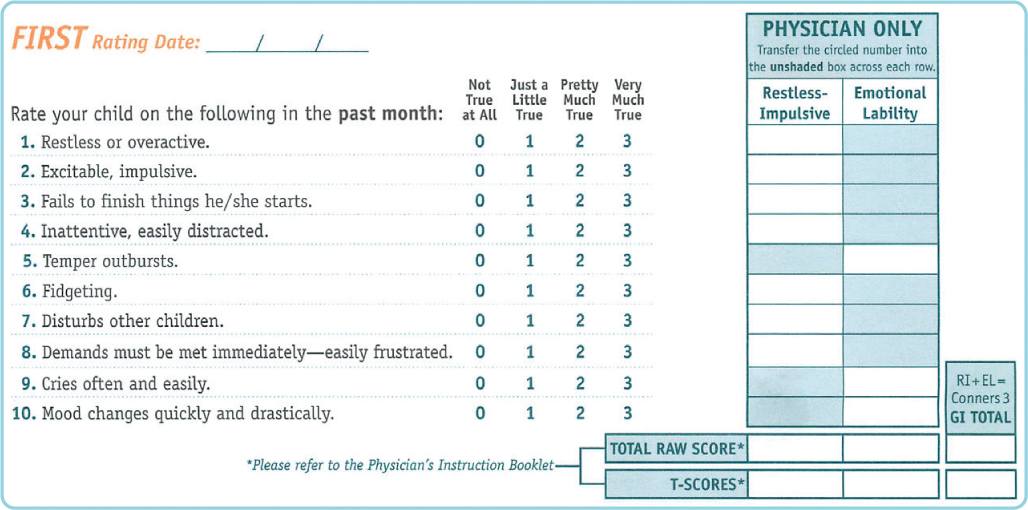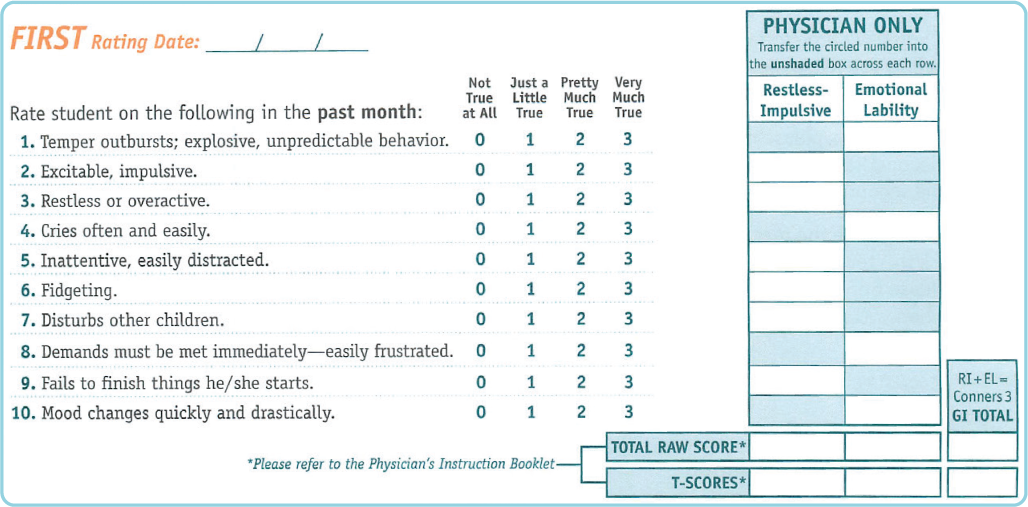Clinical Trial Scales Scales used in clinical trials of ADHD Scales used in clinical trials of ADHD
The rating scales commonly used in clinical trials are used to measure the efficacy of interventions. Some specific functions of ADHD clinical trial rating scales include:
Determine if a patient meets the DSM criteria for a diagnosis of ADHD (See Epidemiology Section)
Assess current symptoms of ADHD
Evaluate response to treatment for ADHD
Safety scales
The rating scales commonly used in clinical trials are used to measure the efficacy of interventions. Some specific functions of ADHD clinical trial rating scales include:
Determine if a patient meets the DSM criteria for a diagnosis of ADHD (See Epidemiology Section)
Assess current symptoms of ADHD
Evaluate response to treatment for ADHD
Safety scales
| Age | Administration | Content | Scoring | Use |
|---|---|---|---|---|
|
|
|
|
|
|
| Age | Administration | Content | Scoring | Use |
|---|---|---|---|---|
|
|
|
|
|
|
For preschoolers and adults, ADHD-RS-IV can be used (See Diagnostic Scales section)
A non-official version for adults called ADHD-RS-DSM V has been used in clinical studies58
| Age | Administration | Content | Scoring | Use |
|---|---|---|---|---|
|
|
|
|
|
|
| Age | Administration | Content | Scoring | Use |
|---|---|---|---|---|
|
|
|
|
CGI-S
CGI-I
|
|
Brief, easy to use, and captures clinical impressions when administered by an experienced clinician.
| Age | Administration | Content | Scoring | Use |
|---|---|---|---|---|
|
|
|
|
|
|
| Age | Administration | Content | Scoring | Use |
|---|---|---|---|---|
|
|
|
|
|
|
| Age | Administration | Content |
|---|---|---|
|
|
|
|
| Scoring | Use | |
|
Level of impairment on a scale of 0 to 6
|
|
|
| Age | Administration | Content |
|---|---|---|
|
|
|
61 questions in 7 symptom categories:
|
| Scoring | Use | |
|
Scoring scale is 0 to 2
Summarizes each of the 7 categories on a 0-to-4 scale
|
|
|
Subset of 25 questions associated with ADHD
| As a child I was (or had) | |
|---|---|
|
3 |
concentration problems easily distracted |
|
4 |
anxious worrying |
|
5 |
nervous fidgety |
|
6 |
inattentive daydreaming |
|
7 |
hot- or short-tempered low boiling point |
|
9 |
temper outbursts tantrums |
|
10 |
trouble with stick-to-it-tiveness not following through. failing to finish things started |
|
11 |
stubborn strong-willed |
|
12 |
sad or blue depressed unhappy |
|
15 |
disobedient with parents rebellious sassy |
|
16 |
low opinion of myself |
|
17 |
irritable |
|
20 |
moody ups and downs |
|
21 |
angry |
|
24 |
acting without thinking impulsive |
|
25 |
tendency to be immature |
|
26 |
guilty feelings regretful |
|
27 |
losing control of myself |
|
28 |
tendency to be or act irrational |
|
29 |
unpopular with other children didn't keep friends for long didn't get along with other children |
|
40 |
trouble seeing things from someone else's point of view |
|
41 |
trouble with authorities trouble with school visits to principal's office |
| As a child in school I was (or had) | |
|
51 |
overall a poor student slow learner |
|
56 |
trouble with mathematics or numbers |
|
59 |
not achieving up to potential |
May be particularly useful in assessing mood lability symptoms of ADHD.
Website links are true and correct at the time of publication.
References
46. DuPaul GJ. Parent and teacher ratings of ADHD symptoms: Psychometric properties in a community-based sample. J Clin Child Psychol. 1991; 20:242.
48. DuPaul GJ, Power TJ, Anastopoulos AD, Reid R. ADHD Rating Scale-5: Checklists, Norms, and Clinical Interpretation. New York: The Guilford Press; 2018.
56. Adler L, Cohen J. Diagnosis and evaluation of adults with attention-deficit/hyperactivity disorder. Psychiatr Clin North Am. 2004;27(2):187-201.
57. Kessler RC, Green JG, Adler LA, Barkley RA, Chatterji S, Faraone SV, et al. The structure and diagnosis of adult ADHD: an analysis of expanded symptom criteria from the Adult ADHD Clinical Diagnostic Scale (ACDS). Arch Gen Psychiatry. 2010;67(11):1168–1178.
58. Ustun B, Adler LA, Rudin C, et al. The world health organization adult attention-deficit/hyperactivity disorder self-report screening scale for DSM-5. JAMA Psychiatry. 2017;74:520-526.
59. Spencer TJ, Adler LA, Saylor KE, et al. Validation of the adult ADHD investigator symptom rating scale (AISRS). J Attention Disorders. 2010;14(1):57–68.
60. Rapoport J. Rating scales and assessment for use in paediatric psychopharmacology research: Clinical Global Impression. Psychopharmacology Bulletin. 1985;21:839-841.
63. Wigal SB, Wigal TL: The laboratory school protocol: Its origin, use, and new applications. J Atten Disord. 2006;10:92–111.
64. Swanson, JM. School-based assessments and interventions for ADD students. K.C. Publishing; Irvine, CA: 1992.
65. Wender PH, Ward MF, Reimherr FW, Marchant BK. ADHD in adults. J Am Acad Child Adolesc Psychiatry. 2000;39:543.
66. Ward MF, Wender PH, Reimherr FW. The Wender Utah Rating Scale: An aid in the retrospective diagnosis of childhood Attention Deficit Hyperactivity Disorder. Am J Psychiatry. 1993;150:885-890.
75. Pennsylvania State University. STAT 509: Design and Analysis of Clinical Trials. 3.3: Experimental Design Terminology. Available at https://onlinecourses.science.psu.edu/stat509/node/21/.
76. Wigal SB, Wigal TL. The Laboratory School Protocol: Its origin, use, and new applications. Journal of Attention Disorders. 2006;10(1):92-111.



